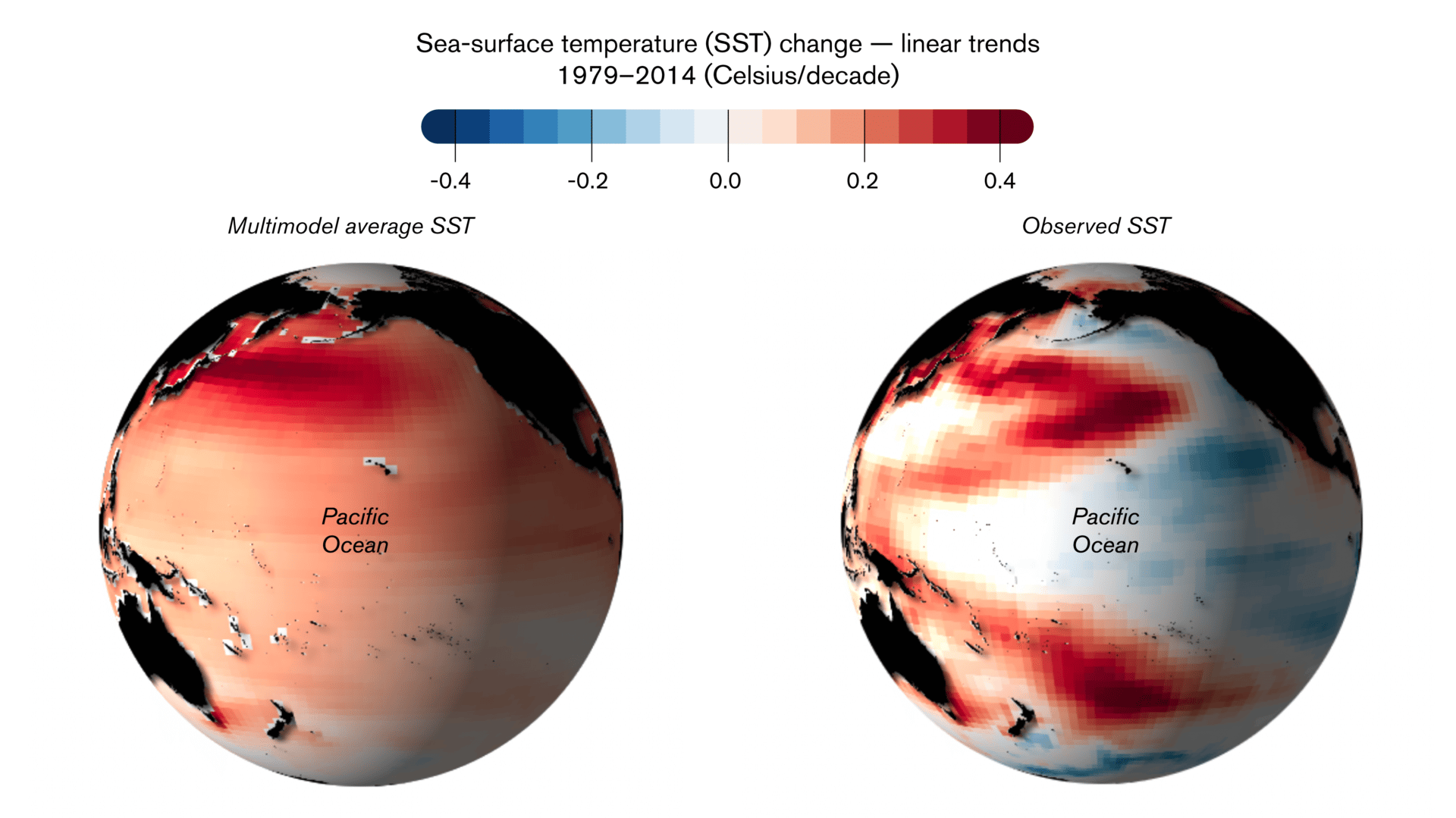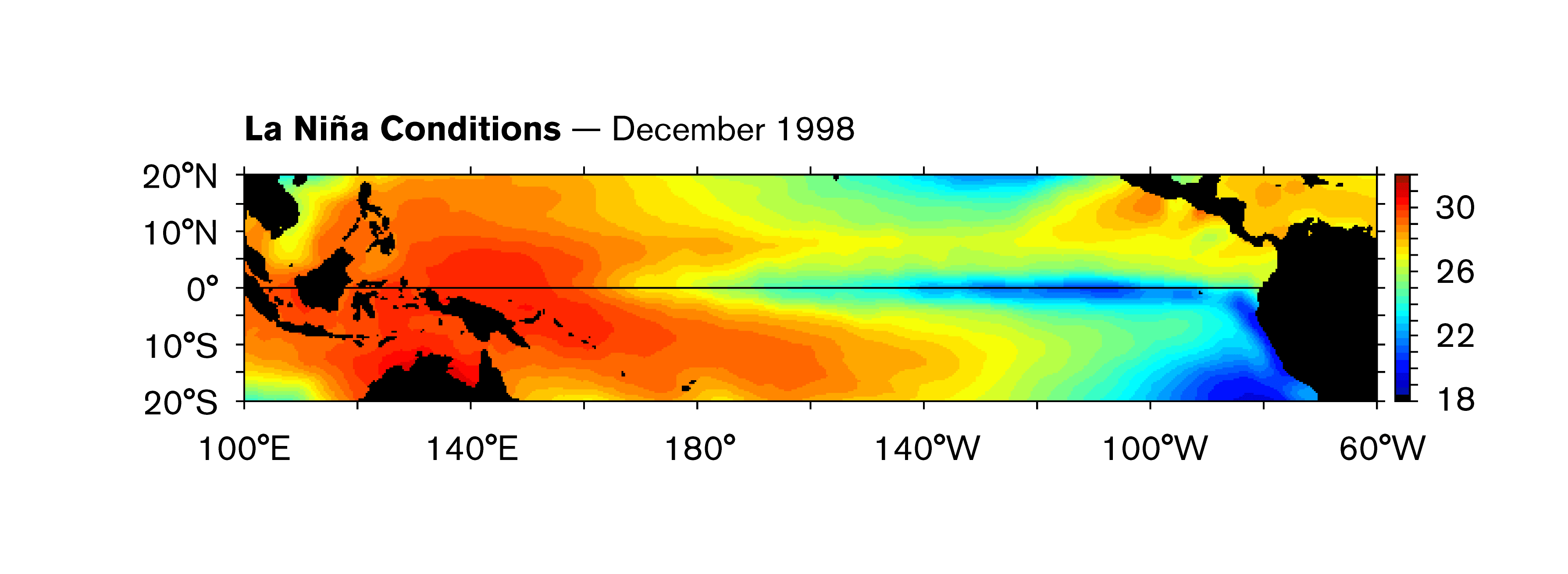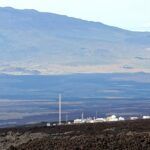What’s wrong with these climate models?
By Chad Small | December 16, 2022
 A cooling Eastern Pacific strengthens the Walker circulation, increasing low-elevation cloud cover and reducing the effects of global warming. But this will also bring regional weather changes, some devastating, from Indonesia to Southern California. (Photo by Harrison Steen on Unsplash)
A cooling Eastern Pacific strengthens the Walker circulation, increasing low-elevation cloud cover and reducing the effects of global warming. But this will also bring regional weather changes, some devastating, from Indonesia to Southern California. (Photo by Harrison Steen on Unsplash)
How often have you been caught in the rain unexpectedly and wondered, “What’s the use of forecasters if they can’t even get the weather right?” While this complaint misses the complexity and accuracy of modern forecasting, it gets at a reasonable concern: Can we predict the future of our planet and its climate?
Take, for example, ocean warming. Despite criticisms from climate change skeptics, global climate models have accurately predicted rising average sea surface temperatures, which are extremely important to predicting the intensity of climate change. But observations in recent decades show that changes in sea surface temperatures vary greatly by region. That geographic variation suggests that end of century global warming may be less severe than most climate models suggest. These observations do not invalidate climate modeling, but they do highlight the importance of regular comparisons between climate models and the real-world observations they aspire to reflect.
Ocean warming is a consequence and a strong indicator of global warming. With ocean warming come changes—sometimes catastrophic—to both weather and climate. From more severe rainfall to potentially stronger hurricanes, these changes also come with societal impacts, so understanding them is of the utmost importance.
Global climate models and real-world observations mostly agree on average ocean warming over the last 40 years. But this agreement breaks down when you peel back that average and look at regional snapshots of sea surface temperature.
“If you have ever looked at [sea surface temperature] linear trend over the past 40 years, since 1979, where we have the set of products with a more accurate [sea surface temperature] estimate, you can see everywhere is warming—of course not uniformly,” Yue Dong, a postdoctoral research scientist at Lamont-Doherty Earth Observatory at Columbia University, and one of the primary authors of a recent paper on this topic, said.
She adds that observed trends show a strong cooling trend in the Eastern Pacific and Southern Ocean, which goes against what the models predicted.

In particular, because the Eastern Pacific is cooling while the Western Pacific is warming, it will yield a very different global warming outcome than if the ocean warmed more uniformly.
As David Battisti, a professor of Atmospheric Sciences at the University of Washington and one of Dong’s coauthors, explains, if reality matched the models, the clouds over the Eastern Pacific would start to break up. While all clouds have the potential to reflect the sun’s radiation, the clouds in the Eastern Pacific are lower altitude clouds and reflect more solar radiation back into space than their taller, colder counterparts in the Western Pacific. Less cloud cover means the Eastern Pacific would continue to warm, effectively reducing the absolute temperature difference between each side of the Pacific Ocean. That would weaken the Walker circulation, a naturally occurring atmospheric circulation pattern in the Pacific that, among other things, maintains clouds in the Eastern Pacific.
But a cooling East Pacific has the opposite effect: strengthening the Walker circulation and building more reflective clouds in the East Pacific.
“We found ‘okay models cannot reproduce observations’,” Dong explained. “That should be a big problem because that tells us if something is wrong with models’ forcing or forced response that might tell us something is wrong with their future projections.”
While that may be a troubling problem for climate scientists, it means that based on observed Eastern Pacific cooling, the models are very likely overshooting end of century global warming estimates, Battisti and Dong said. Even with an active greenhouse effect, these stronger Eastern Pacific clouds still reflect a non-negligible amount of solar radiation back to space, bringing down overall warming.
“You’ll still have global warming,” Battisti said. “It’ll get warmer more and more as [you] increase CO2, but not as fast as it would be if the warming was more in the East than the West.”
The models showing more evenly distributed increases in sea surface temperature would have end of century global warming as high as 5 degrees Celsius, in the most extreme cases. If the current observations hold, however, end of century warming looks more like 2 degrees Celsius of global warming.
Of course, even if this is positive news for overall global warming, the observed trends in sea surface temperature changes can still cause regional crises. A cooling Eastern Pacific coupled with a warming Western Pacific quickly starts to mimic La Niña conditions.

During La Niña years, the equatorial portions of the Eastern Pacific experience colder temperatures. These cold ocean temperatures bring with them a myriad of effects, including heavier rainfall in Northern Brazil and Southeast Africa. Meanwhile, the west coast of South America, the Gulf Coast of the United States, and Southern California especially, see considerably drier conditions.
La Niña can bring mild changes in precipitation, as well as catastrophic weather events. Parts of Northern Australia are far more likely to experience destructive flooding from excess rainfall in La Niña years, for example.
The potential of perpetual La Niña-like effects from a cooling Eastern Pacific could exacerbate existing climate and weather challenges. With already serious drought conditions in Southern California, a prolonged—potentially never-ending—lack of precipitation could be catastrophic.
Regions that experience greater precipitation would see the opposite effects. “Rain will never wander from Indonesia,” Battisti said.
This could aggravate life-threatening flooding in the region.
Given that we could see very different climate outcomes from model projections, improving the models is paramount. But what exactly needs fixing?
While the global climate models integrate many different physical parameters, they don’t have everything. One important missing variable is aerosol composition. The reflective properties of aerosols in the atmosphere can change the Earth’s climate sensitivity, and consequently ocean temperatures. But Battisti notes that work done linking aerosols to the Eastern Pacific cooling has been inconclusive. This leaves one other possible culprit: glacial meltwater.
“We [found] this model-observation discrepancy mostly in the tropical Pacific and also in the Southern Ocean which leads me to think whether these two regions have any connection to each other,” Dong said.
This led Dong to try placing the cold-water flux from Antarctic meltwater—which is already a consequence of climate change—in the global climate models. With the addition of the meltwater, the models accurately replicated the Eastern Pacific cooling trend. But making a change like this at scale is difficult to implement because it was added to the models as a physical anomaly, as opposed to the continuous flow of natural systems, Dong explained. Getting the models to include this meltwater automatically is a computational hurdle yet to be crossed.
Moreover, not everyone in the broader scientific community agrees that meltwater is the missing link. According to Battisti and Dong, there are scientists who think this cold effect in the Eastern Pacific is a result of natural variation in the Earth system. The ocean temperature observational record only goes back about 40 years, so it isn’t yet complete enough to capture processes with much longer periods of oscillation.
“We can’t really robustly detect whether it’s natural variability or a forced response,” Dong clarified. “Maybe in the coming 40 or 50 years the observation becomes the opposite pattern, and in that case, models are still doing fine.”
The cooling of the Eastern Pacific could also be due to both some natural oscillation in the Earth system and the Antarctic meltwater happening simultaneously. Without a longer observational record, it’ll be hard to tell definitively. As Dong highlights, this model discrepancy issue proves it’s important to “critically examine models’ performance and constantly compare [them] to observations.” Accurately forecasting global warming and regional weather events depends upon it.
Together, we make the world safer.
The Bulletin elevates expert voices above the noise. But as an independent nonprofit organization, our operations depend on the support of readers like you. Help us continue to deliver quality journalism that holds leaders accountable. Your support of our work at any level is important. In return, we promise our coverage will be understandable, influential, vigilant, solution-oriented, and fair-minded. Together we can make a difference.
Topics: Climate Change
















While this is an interesting observation, the text fails to mention the Pacific Decadal Oscillation, which acts like a gigantic El Niño-La Nina couplet over periods of about 25 years, and which, in its negative phase, brings cool conditions to the eastern equatorial Pacific and warm conditions to the Gulf of Alaska. As I understand it, the PDO is, like ENSO, a natural internal oscillation within the climate system. Models cannot yet resolve natural oscillations like these (including the Atlantic equivalent, the Atlantic Multidecadal Oscillation). With the eventual decline of the PDO and La Niña, the eastern equatorial Pacific should… Read more »